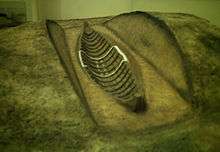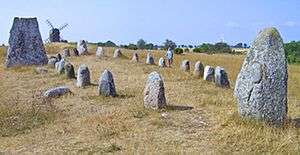Ship burial
A ship burial or boat grave is a burial in which a ship or boat is used either as a container for the dead and the grave goods, or as a part of the grave goods itself. If the ship is very small, it is called a boat grave. This style of burial was used among the Germanic peoples, particularly by Viking Age Norsemen. According to the Boxer Codex, ship burials were also practiced by the people of the Philippines prior to colonisation in the 15th century.

A unique eyewitness account of a 10th-century ship burial among the Volga Vikings is given by Arab traveller Ibn Fadlan.[1] The largest Viking ship grave, 65 feet (20 m) long, was discovered in Norway by archeologists in 2018, and it is estimated to have been covered over 1000 years ago to be used as a boat grave for an eminent Viking king or queen.[2]
Viking Age ship burials
Scandinavia
- Denmark
- Ladby – from Kerteminde on the island of Funen, Denmark[3]
- Norway
- Gokstad – from Kongshaugen, Vestfold, Norway[4]
- Oseberg – from Oseberg farm near Tønsberg in Vestfold, Norway[5]
- Tune – from Haugen farm on Rolvsøy in Tune, Østfold, Norway[6]
- Gjellestad – from the farm of the same name; excavations ongoing as of June 2020.[7]
- Sweden
- Valsgärde – from a farm on the Fyris River, Gamla Uppsala, Sweden
- Vendel – from Ottarshögen (the mound of Ohthere) in Uppland, Sweden
- Anundshög – the mound of Anund just outside Västerås in Västmanland, Sweden[8]
- Nabberör near Nabbelund, Öland – a ship burial from the Vendel Period[9][10] with four skeletons,[11] formerly covered by a cairn and now heavily damaged.[12]
British Isles
Norse burial in British Isles
- Balladoole and Knock-e-Dooney – Viking ship burials in the Isle of Man[13]
- Port an Eilean Mhòir – The only Viking burial yet discovered in mainland Britain, the mound was found in 2006 and excavated in 2011.[14]
- The Scar boat burial – a Viking burial found on Sanday, one of the Orkney Islands.[15]
England
- Snape from Snape Common in Suffolk
- Sutton Hoo Anglo-Saxon burial site near Woodbridge, Suffolk
Northern Europe
- Salme ships – from the island of Saaremaa, Estonia
Eastern Europe
- Rurikovo Gorodishche – situated on an island on the Volkhov River near Veliky Novgorod, Russia
- Sarskoye Gorodishche – from a medieval fortified settlement in Yaroslavl Oblast, Russia
- Timerevo – from site near the village of Bolshoe Timeryovo, Yaroslavl, Russia
- Black Grave – from the largest burial mound in Chernihiv, Ukraine
See also
![]()
- Norse funeral
- Ímar Ua Donnubáin, legendary Irish navigator of partial Norse descent
- Stone ship
- Chariot burial (Iron Age tradition)
- Solar barge (Bronze Age tradition)
- Khufu ship (Ancient Egypt)
References
- Ibn Fadlan and the Land of Darkness: Arab Travellers in the Far North (Penguin Classics 2012, ISBN 9780140455076), Introduction by Paul Lunde and Caroline Stone, pp. xxiii–xxiv.
- "Enormous, rare Viking ship burial discovered by radar". National Geographic. October 15, 2018.
- "The Viking Ship Museum in Roskilde". Archived from the original on September 14, 2017. Retrieved Jun 20, 2020.
- "Gokstadhaugen". The Megalithic Portal. Retrieved Jun 20, 2020.
- Osebergskipet – The Oseberg Ship, Norway Archived 2007-02-11 at the Wayback Machine
- Viking Ship Museum at Bygdøy Archived 2011-10-06 at the Wayback Machine
- Science Norway
- "Anundshög, Stoneship". Archived from the original on September 28, 2007. Retrieved Jun 20, 2020.
- Larsson, Gunilla (2007). Ship and society: maritime ideology in Late Iron Age Sweden. Uppsala Universitet, Department of Archaeology and Ancient History. p. 415. ISBN 9789150619157.
- Incorporated, Walter De Gruyter (2002). Naualia – Ãstfold. Walter de Gruyter. p. 595. ISBN 9783110903515.
- Strömberg, Märta (1961). Untersuchungen zur jüngeren Eisenzeit in Schonen: Textband. Mit einem Beitrag von J. Lepiksaar. R. Habelt.
- Mikroficheupplaga av Tillväxten. Kungl. Vitterhets, historie och antikvitets akademien. 1946. p. xcix.
- "Vikings on Mann" (PDF). Archived from the original (PDF) on March 31, 2012. Retrieved Jun 20, 2020.
- "Viking boat burial site discovered in Scottish Highlands". Channel 4 News. Retrieved 2011-10-19.
- "Orkneyjar - The Scar Viking Boat Burial, Sanday". www.orkneyjar.com. Retrieved Jun 20, 2020.
